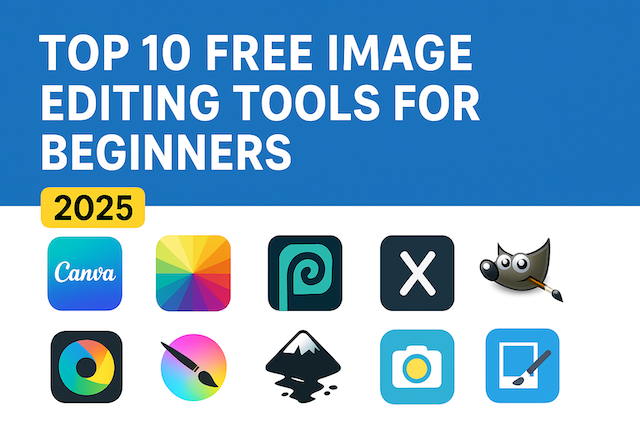Introduction
In today’s digital age, high-quality visuals are essential—whether you’re creating social media posts, blog graphics, or marketing materials. But if you’re a beginner, expensive software like Photoshop might feel intimidating or unnecessary. The good news? There are plenty of free image editing tools that are beginner-friendly, powerful, and accessible online.
In this guide, we’ll review the top 10 free image editing tools in 2025 that can help you create professional-looking visuals without spending a dime.
1. Canva
Best for: Social media graphics and quick designs.
- Key Features: Drag-and-drop interface, 250,000+ free templates, stock photos, built-in text effects.
- Pros: Extremely beginner-friendly, mobile app available, collaborative features.
- Cons: Limited advanced editing compared to Photoshop.
2. Fotor
Best for: Quick photo touch-ups and design.
- Key Features: One-click photo enhancement, HDR effects, collage maker.
- Pros: Intuitive interface, fast editing.
- Cons: Ads in the free version.
3. Photopea
Best for: Photoshop-like editing in your browser.
- Key Features: Layer support, PSD compatibility, advanced filters.
- Pros: No installation needed, works with multiple file types.
- Cons: Interface can feel overwhelming for total beginners.
4. Pixlr X
Best for: Simple online photo editing.
- Key Features: AI background remover, preset filters, overlays.
- Pros: Lightweight, fast loading.
- Cons: Occasional ads in free mode.
5. GIMP
Best for: Open-source Photoshop alternative.
- Key Features: Layers, advanced retouching tools, plugins.
- Pros: Completely free, powerful features.
- Cons: Steeper learning curve.
6. BeFunky
Best for: Quick edits and fun graphics.
- Key Features: Collage maker, touch-up tools, vector graphics.
- Pros: Beginner-friendly, web-based.
- Cons: Limited export quality in free version.
7. Krita
Best for: Digital painting and illustration.
- Key Features: Brushes, stabilizers, animation support.
- Pros: Great for artists, fully free.
- Cons: Less suited for quick photo edits.
8. Inkscape
Best for: Vector graphics editing.
- Key Features: SVG editing, bezier curves, shape tools.
- Pros: Free alternative to Adobe Illustrator.
- Cons: Not ideal for raster photo editing.
9. iPiccy
Best for: Quick online photo enhancement.
- Key Features: Filters, basic retouching, collage tools.
- Pros: Easy to use, no sign-up required.
- Cons: Fewer features than competitors.
10. Paint.NET
Best for: Windows users seeking simplicity.
- Key Features: Layers, special effects, plugin support.
- Pros: Lightweight, responsive.
- Cons: Windows-only.
How to Choose the Right Tool
When choosing a free image editor, consider:
- Ease of use: Is it intuitive enough for your current skill level?
- Features: Does it support the type of editing you need (photo retouching, vector work, design)?
- Platform: Does it work on your device and operating system?
Conclusion
Whether you’re making a quick social media post or working on detailed digital art, there’s a free image editing tool out there for you. The tools above offer plenty of functionality without costing a cent—making them perfect for beginners eager to create professional-looking visuals.


Leave a Reply